Washing your car at home sounds like a simple weekend task. You grab a sponge, fill a bucket with soapy water, and start scrubbing. But here’s the truth: most car owners unknowingly make small mistakes during these DIY wash sessions that can lead to paint damage, faded trim, or even moldy interiors over time. These errors can cost more to fix than what a professional detailing session would’ve charged in the first place.
In this guide, we’ll break down the most common cleaning mistakes drivers make, why they’re problematic, and what you should do instead. Whether you’re trying to maintain a shiny exterior or protect your car’s interior investment, this will help you clean smarter—not just harder.
Key Highlights
- Dish soap strips your car’s wax and harms the paint’s protective layers.
- Cleaning in direct sunlight leads to streaks, water spots, and soap stains.
- Skipping the interior can lead to permanent upholstery or electronic damage.
- Drying improperly causes swirl marks and mineral deposits to form.
- Ignoring the undercarriage allows rust and salt to slowly eat away at your car.
- Using household towels or dirty tools will scratch your vehicle over time.
Why Cleaning in Direct Sunlight Is a Problem
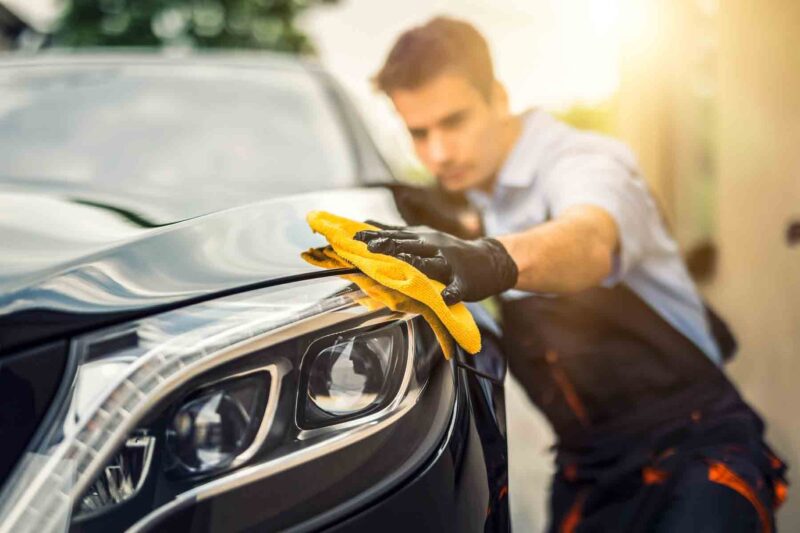
The sunny driveway might seem like the perfect spot to wash your car. But if you’ve ever noticed streaks, water spots, or soap stains right after drying, there’s a reason: heat and sunlight accelerate water evaporation. When water dries too fast, it leaves behind minerals and chemical residues that can damage your car’s clear coat. This is especially a problem with hard water.
When your car’s surface is hot, even the best car shampoo will dry before you can rinse it off properly, leaving behind ghostly streaks or dull patches. Over time, these spots become etched into the clear coat and reduce your vehicle’s shine permanently.
What to do instead: Aim to wash your car either early in the morning or late in the afternoon. Better yet, find a shaded area like a carport or tree-lined spot. This gives you time to properly rinse, wash, and dry your vehicle without racing against the sun.
Skipping Interior Cleaning or Doing It Wrong
It’s easy to focus on the exterior—after all, that’s what everyone sees. But the interior is where you spend most of your time. Spills, dirt, oils from your skin, and even moisture from your shoes all contribute to long-term wear and tear. If ignored, that buildup can ruin upholstery, stain floor mats, and even cause electronics to malfunction.
Vacuuming alone isn’t enough. Air vents accumulate dust, dashboards fade without UV protection, and leather dries out and cracks without proper conditioning.
Dish Soap: Great for Dishes, Terrible for Cars
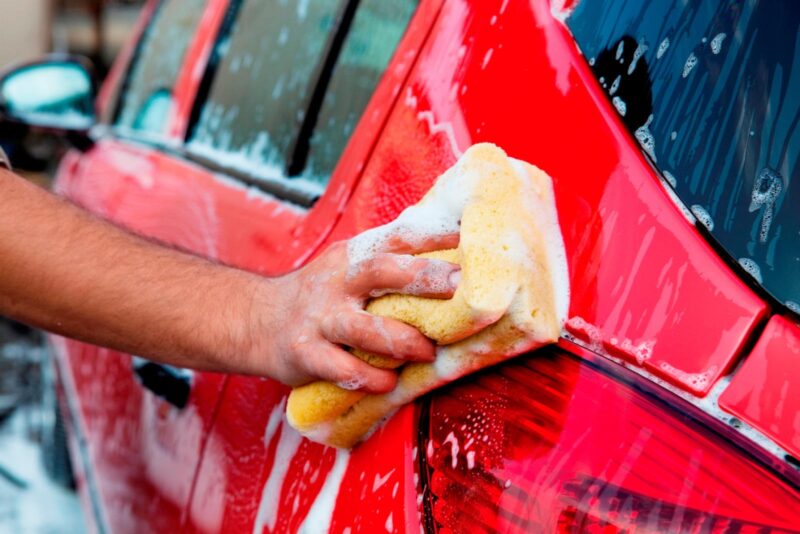
It’s one of the most common DIY mistakes: reaching for dish soap. While it’s excellent at cutting grease in the kitchen, it’s far too aggressive for your car’s paint. Dish soap strips away wax and protective coatings, and if used repeatedly, it can dry out rubber trim and fade the finish.
Think about it like this: car paint is protected by a clear coat, and on top of that, many car owners apply wax or sealants. These layers defend against UV rays, bird droppings, road grime, and acid rain. Dish soap eats away at these layers.
The solution: Use a pH-balanced car shampoo specifically designed for vehicle exteriors. These cleaners are formulated to lift dirt without compromising your paintwork or protective wax. They rinse clean and keep your car looking newer, longer.
Reusing Dirty Sponges and Old Towels
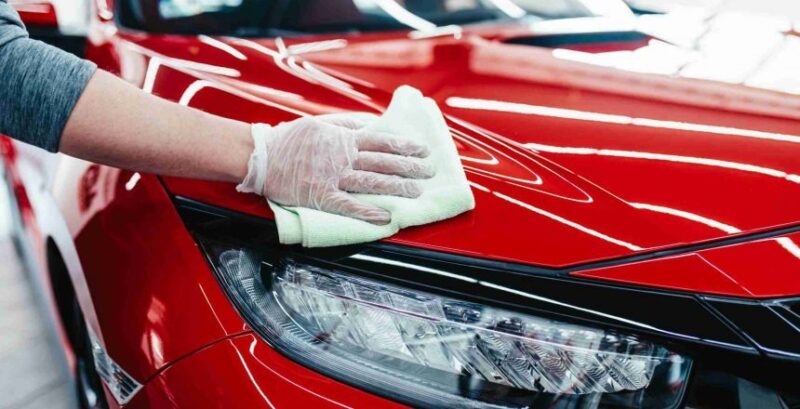
One of the worst habits when washing at home is using a sponge or towel that’s already dirty. You might not see the grit stuck in it, but your car definitely will—every swipe acts like sandpaper against the paint. Even worse is when someone drops a sponge on the ground, picks it up, and keeps using it without rinsing. That’s a recipe for micro-scratches, swirl marks, and eventually, paint correction bills.
Micro-scratches aren’t always visible immediately, but they accumulate over time and cause the surface to look dull. If you’re using the same towel for wheels, bodywork, and drying, you’re asking for trouble.
Use a proper method: Always use clean microfiber towels and a high-quality wash mitt. After each panel, rinse your mitt in a separate rinse bucket (see next section) to release trapped debris. Retire any towel that’s been dropped or that has hardened edges from previous uses.
Not Following the Two-Bucket Method
If you’re serious about protecting your car’s paint, the two-bucket method is a must. Here’s how it works: one bucket contains soapy water, and the second is filled with clean water for rinsing your mitt between uses. This reduces the chance of transferring dirt and grit from one part of the car to another, which is the biggest culprit behind those annoying swirl marks.
Without the two-bucket system, all the road grime from the lower panels ends up back in your clean water—meaning you’re just smearing the same contaminants around the vehicle. Not only does this dull your paint over time, but it can also make your clear coat more susceptible to deeper scratches.
Tip: As explained by detailing experts from Grandeur Autos, for even more protection, place a grit guard at the bottom of each bucket and you will trap particles underneath and keep your mitt from picking them up again.
Ignoring the Undercarriage and Wheel Wells
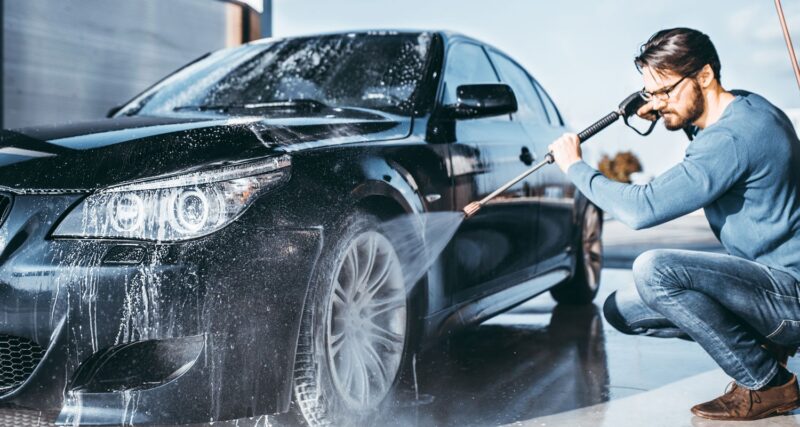
Most people rinse the top of the car and forget about what’s underneath. But your undercarriage is constantly exposed to road salt, dirt, oil, and grime—especially if you live in a snowy climate. Over time, that buildup causes rust and corrosion, particularly around wheel wells, suspension components, and brake lines.
It’s not just cosmetic damage; it can impact your vehicle’s performance and even your safety.
Pro tip: Use a hose with strong pressure or a dedicated undercarriage washer attachment to flush out debris. At least once a month during winter, rinse underneath thoroughly. And when spring arrives, do a full deep clean to remove months of salt and buildup.
Poor Drying Habits
Drying your car correctly is just as important as washing it. Letting it air dry leads to water spots and mineral stains. Worse, using household bath towels can cause abrasion. Even “soft” towels aren’t designed to handle delicate auto finishes.
Blotting with the wrong materials or using circular motions with dry cloths can create swirl marks that only professional buffing can remove.
Dry the smart way: Use large, plush microfiber drying towels. Gently blot or drag the towel across panels in straight lines. If you want a contactless method, use a leaf blower or car dryer to blow water off the surface, especially from trim and mirror crevices where it can pool and drip later.
Skipping Protective Layers Like Wax or Sealant
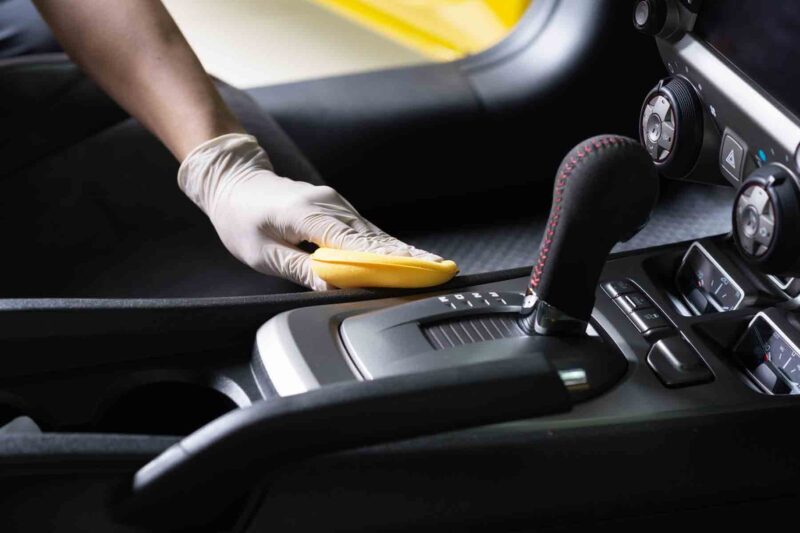
After all that cleaning, skipping wax or sealant is like showering and forgetting deodorant. You’ve cleaned off the grime, but now your paint is exposed to everything the environment throws at it. Without a protective layer, your car’s clear coat is more vulnerable to sun damage, bird droppings, tree sap, and road debris.
A good wax or sealant repels water, resists contaminants, and enhances the depth and gloss of your paint. It also makes future washes easier by allowing dirt to slide off instead of sticking.
Best practice: Apply wax every 2-3 months, or use a ceramic spray sealant for a longer-lasting shield. Even a quick detailer spray after each wash can help prolong your paint’s health.
The Right Habits Make All the Difference
Cleaning your car at home should be rewarding, not costly. But without the right techniques, what seems like basic maintenance can actually do more harm than good. From faded paint to scratched surfaces and musty interiors, the long-term impact of bad cleaning habits adds up fast.
The good news? These mistakes are entirely preventable. With the right tools, products, and a little patience, you can wash your vehicle like a pro—or better yet, trust skilled detailers to give it the care it deserves.
If you’re looking to get your interior back to showroom condition—or just want to skip the hassle altogether—professional interior detailing in Calgary is a smart investment.

